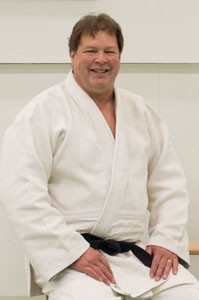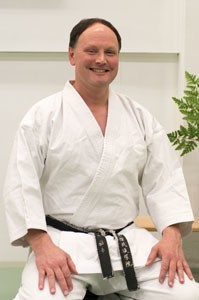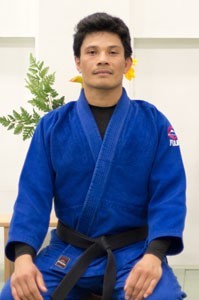Judo Instructors
BMAI is a member of the United States Judo Association (USJA), the United States Federation (USJF), and the Judo Northwest Yudanshakai. All BMAI judo instructors are nationally certified black belts.

I started judo under Sensei Park, Sung Jae at Ball State University in September 1971. I took Judo as a PE class and Judo 2 the following term. While at the university I trained for over two years (1971-73). I was on the Ball State University Judo Team as the 154 lb competitor. At the end of this time I had achieved the rank of sankyu (brown belt) recognized by the U. S. Judo Federation. I was inducted into the U.S. Army in 1973.
I next moved to the Fort Hood Judo Club. There I was the assistant instructor and continued my training with the other judo players in the club. I was competing heavily and through special services was placed on the U.S. Army Judo Team. As part of the Army Team I was selected to attend Camp Olympus Judo Training Camp in Virginia. From this camp Olympic hopefuls were picked. The coaching staff at the camp was the national Japanese Olympic Coaching staff and Olympic Gold Medalist Anton Geesink. We did train and compete for seven days ending in a tournament to help select Olympic hopefuls. I placed fourth in my division.
Returning to Ft. Hood to complete my military term, I worked for Special Services in the evening teaching self defense class to military officers and their dependents who were to be assigned overseas. (I used this as a ruse to encourage potential students to join the Ft. Hood Judo Club.) At one point we had over 80 members.
After the military, I returned to Ball State University (1975-77) and continued my training with Dr. Park at the Ball State Judo Club. Just after graduation I was promoted to Iikyu Brown Belt (the highest level before black belt). I moved to Chicago to attend graduate school at the University of Illinois. In Chicago I trained at the Oak Park Judo Club for two years. This was a small club (5-8 people). So, to improve my skills I traveled to other judo clubs in the Chicago area on a regular basis. My wife and I worked out at Uptown Dojo and several Korean and American clubs in the area.
When I moved to Oregon in 1978 I asked my Sensei (Dr. Park) where I could train. He referred me to another alumnus from the Korean Yudo (Judo) College, Master Hwang, Kyu Chin. I trained with Sensei Hwang from 1978-2003. During that time I competed locally and regionally, winning the Oregon State Championships several times. At 35 years old I retired from competition. I was promoted from shodan (first degree black belt) to sandan (third degree black belt) while training at Master Hwang’s.
In 2004 I began training with the judo club at Best Martial Arts Institute in Eugene, Oregon. I had no teaching responsibilities and I enjoyed the opportunity to train with my son and the other members of the club. After having played judo for over 30 years, it was wonderful to still be able to participate in the sport.
What I find most important in judo is that the beginning students learn the teachings and principles of judo as set forth by its founder, Dr. Jigoro Kano. On or off the mat, in this respect, Sensei Alan Best is a living example of these guidelines. Over time Sensei Best asked me to share my knowledge of judo with the others in the club. Eventually, I was asked to lead some classes, and I became the chief instructor of the Best Martial Arts Institute Judo Program in 2008. I received my Godan (5th degree black belt) in 2021 from the United States Judo Federation. I am also a Certified Rank Examiner for the USJA.
At this point in my judo career I am here to train and teach. I still enjoy playing judo very much. While I am not what I once was, I do occasionally surprise myself. After my competition days ended, my judo goal became to encourage other beginners to give judo a try and see if judo is in their soul, as it is in mine.

Alan Best is the founder and chief instructor of Best Martial Arts Institute in Eugene, Oregon.
Sensei Best began his training in 1974 in Missoula, Montana under Larry Foust, a student of Grand Master Ken (Kyung Ho) Min. In 1978, Best became a student of Kancho Shigeki Umemoto, the founder of Toushi Kan Karate, who is also a taekwondo, judo and hapkido master under Grand Master Jae Ho Park.
In 1980, Best earned his black belt in both karate and taekwondo. From 1980-1991 he competed in eight U.S. National Taekwondo Championships, placing in the top 8 four of those years. In 1986, he won the heavyweight division at the Asia-Pacific Full Contact Kyokushin Karate Championships.
In 1982, at 18, Best was accepted as an uchideshi (apprentice) under Master Umemoto. He spent the next six years completely immersed in training and teaching martial arts. During this time he trained in karate, taekwondo, judo, hapkido, and kendo. He lived off a small stipend and spent 12-14 hours a day at the dojo.
In 1988, Sensei Best made the decision to take the challenge of opening his own school. He dropped a finger on a map and landed in Eugene, Oregon, where he has been teaching and practicing the martial arts ever since.
Sensei Best has been the martial arts coordinator for the Oregon Asian Celebration since 2003 and Regional Coordinator for Washington and Oregon for the United States Judo Association since 2010. He founded the Pacific Martial Arts Conference in 2007.
Sensei Best holds the following black belt ranks: Karate – 6th dan, Taekwondo – 6th dan, Hapkido – 4th dan, Judo – 4th dan, Aikido – 2nd dan

I was born in a small village in Indonesia. Back then, it was common that if you were weak and frail, you were the easy target of many bullies. As a result of being bullied so much, I started to study a means of self- defense. At the beginning I was just watching and imitating villagers practicing Silat, a traditional Indonesian martial art. Training was held at night, in the moon light of the evening among the rice paddies. It was a harsh place where I grew up. Criminals haunted the village with gangs of robberies that kept the villagers awake at night. There was little policing and weak laws. It was common to see either villagers get injured by the thieves, or the thieves get caught and hurt by the villagers. Elders were weary of strangers and taught the secret of their Silat to only a few trusted family members. I was not one of them. Though things have dramatically changed, that period has affected my whole feeling and self-image about the importance of developing oneself through
martial arts training.
My formal training began in 1987, when I was in middle school. I began the art of Karate, under two different organizations: The Shotokan and Kyokushinkai. Both of my teachers were from the military. While the Shotokan emphasized Kata and Bunkai (practical application of the kata moves), Kyokushinkai emphasized Kumite (sparring). Most practices were done on the dirt pavement of a temple or on the elementary school yards. There was no formal dojo (martial arts school) in my village. Yearly rank promotion examinations involving several hundred Karateka gathered from several villages in the main dojo. The hard physical and grueling Kumite is a fond memory that I have. I received the rank of first kyu brown belt (one rank before black belt) by the time I left my country to the United States in 1996.
The same year I came to the US, I was introduce to Sifu David Leung and started my martial arts training in Wing Chun Kung Fu. Through his school, I attended many workshops with Internationally known Kung Fu masters. I was exposed to other styles of Kung Fu such as: Hsing-I and Tai Chi Chuan. I trained with Sifu Leung until I found out that my heart belonged to Judo.
In 1999, I switched my training and began focusing on studying Judo under Master Kyuchin Hwang. Looking back at this time, I am not satisfied with my training, because it focused too much on a tough-guy mentality. It was the search for a balance of philosophy and practical sense of personal development that led me to Best Martial Arts Institute in 2001. Since I stepped my feet through the doors of BMAI I never looked back. I finally found what I was looking for.
Now, I consider BMAI as my school for learning the way of martial arts in a total sense. It is not only that Sensei Best embodies true leadership for me, but he has positively affected the development of my son, Rhian, and hundreds (or thousands) of others. I have had many profound conversations going to the dojo with Rhian, and I know that my son’s thoughtfulness is a direct result of the time he spent at the dojo surrounded by the many beautiful spirits the dojo has brought into his world.
I consider Judo to be my root art for both its practical use and philosophy, but I still continue my study of other martial arts. Besides holding the rank of Sandan (3rd degree black belt) in judo, I am a two-stripe blue belt in Brazilian Jiu Jitsu under Professor Ryan Kelly, 5th kyu in Aikido under Sensei Chuck Hauk at BMAI, and have two years of training in Muay Thai under Ajarn Mike Warlrath. Martial Arts has not only taught me to believe in myself, but it has allowed room for my creativity and learning what my limitations are.